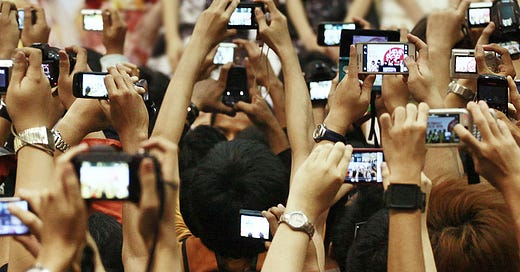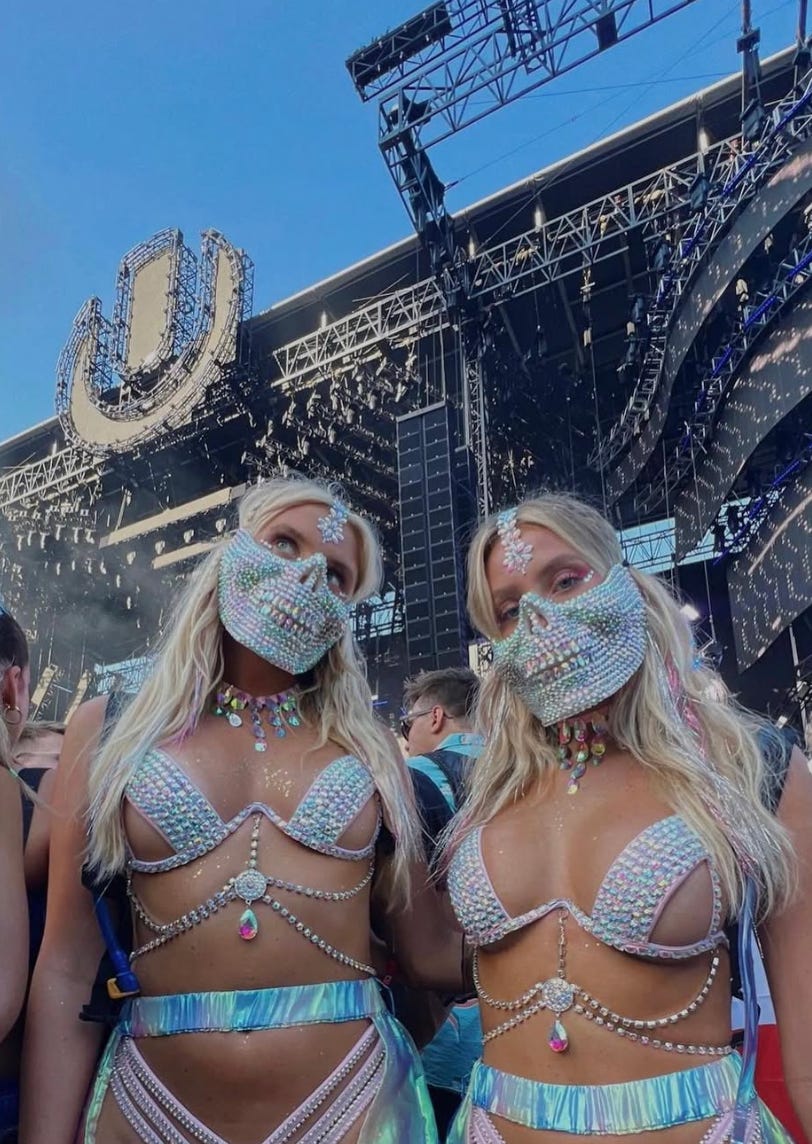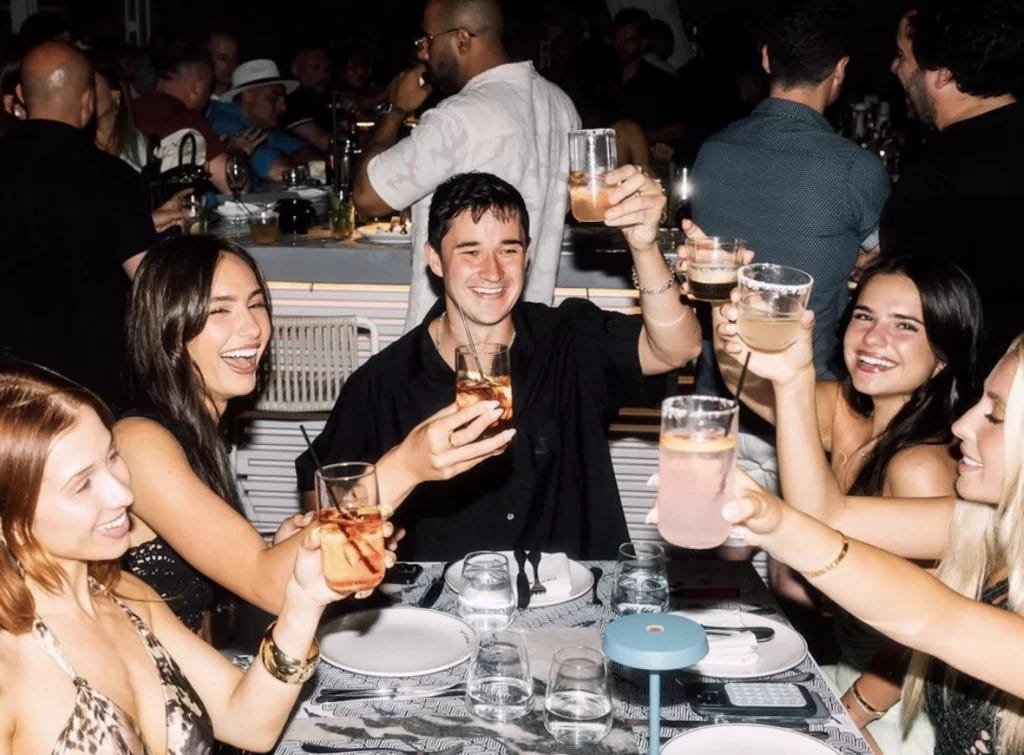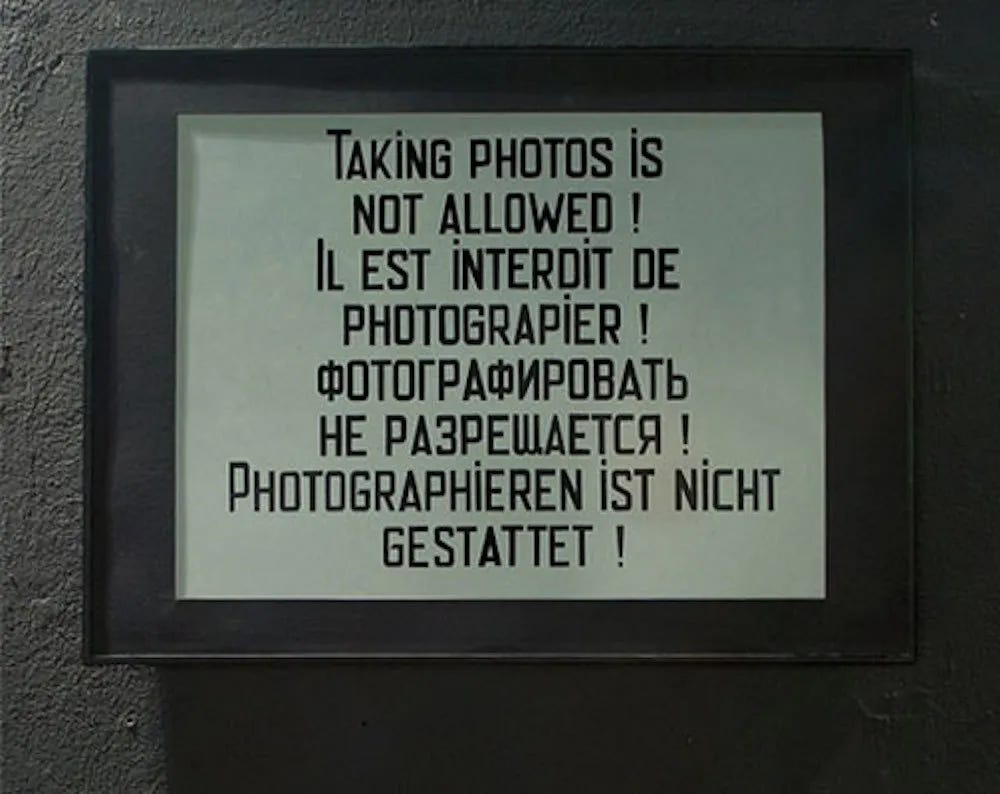You're ruining house music
A commentary on the evolution of EDM in today's digital culture
It was Saturday of Coachella Weekend 2, and the desert air buzzed with the energy of tens of thousands of people. Lights strobed against the sky, bass rumbled through the ground, and everywhere I turned, phones were in the air—filming, posting, live-streaming. Somewhere in the middle of Charli XCX’s sunset set, I spotted him: a man weaving through the crowd, holding a hand-drawn sign above his head. “GET OFF YOUR PHONE AND DANCE!!!,” it read.
He wasn’t part of the production, didn’t seem tied to any brand or artist. Just one guy, drifting from set to set with a piece of cardboard and a message. I spotted him again later that night while dancing to Keinemusik, and again the next day at Sammy Virji’s DJ set. No matter the stage, no matter the crowd, the “sign guy” — as I started calling him on the trip — was always there, planted firmly at the front, his sign held high above his head.
In the middle of one of the world’s most media-saturated festivals, he caught my attention in a way the music and lights couldn’t. While the rest of us were half-lost in our screens, trying to capture memories instead of living them, he was a reminder of what we were losing. Technology is reshaping concert culture, pulling us away from the raw, communal energy that makes live music unforgettable.
In the 1980s, the rise of electronic music like techno and house, paired with MDMA, sparked the “Second Summer of Love.” Warehouse parties became a refuge for young, often working-class adults, offering an escape from the monotony of daily life and a chance to dance until sunrise. House music, which had emerged a few years earlier in Chicago, was shaped by DJs like Frankie Knuckles who blended disco classics with drum machines and synthesizers, creating a fresh sound for a community seeking liberation. These tracks played at small venues, many of which were run by and for LGBTQ, Black, and Latino communities.
Over time, these spaces became cultural havens for misfits, artists, and radicals. As Simon Reynolds writes in Energy Flash: A Journey Through Rave Music and Dance Culture, “Rave is more than music and drugs; it’s a matrix of lifestyle, ritualized behavior, and beliefs. To the participant, it feels like a religion.” The sense of belonging and community was vital, especially as the culture expanded.
At a time when safe spaces for marginalized people were rare, the dance floor became a place to escape, connect, and experience joy without fear. That spirit of radical freedom and togetherness became the blood of house music. But with each shift toward commercialization, the challenge of preserving that essence only grows.
Today, raves have morphed into warehouse “experiences.” What used to be spontaneous and free is now a ticketed event with branded water bottles, VIP sections, and promoters pushing the hot-new-thing online. Venues like Brooklyn Mirage, which once felt like the mecca of New York’s underground house music, have become overcrowded, overpriced spots (AKA $22 for a tequila soda), where it’s less about the music and more about what you’re wearing, where you’re standing (are you on stage behind the DJ, or off to the side with the crowd?) and who’s watching you.
And the shift isn’t just happening in the crowd, it’s bleeding into the DJ sets themselves. More and more artists are tailoring their performances to be spectacles for social media, curating moments designed to go viral rather than crafting an immersive musical journey. I’ve been to sets where the audience wasn’t really listening; they were glued to their phones, waiting for a photogenic beat drop, often punctuated by meme-able tracks, TikTok sounds, or pop culture nods (e.g. White Lotus theme song, etc.).
This brings us to influencers like Alix Earle, who’s become the face of the modern rave scene amongst adolescents with 7.1 million TikTok followers. She’s everywhere, posting perfectly curated shots of herself at Ultra, Coachella, and in Ibiza and Vegas. In the summer of 2024, she made dozens of TikToks and Instagram posts dancing behind DJs like Cloonee and the Chainsmokers around the world—not only physically (and figuratively) above the crowd, but also literally in every video the DJs posted, boosting their visibility and adding to her own brand of celebrity.
But the real question is — is she there for the music or just the content?
Even if her love for the music is genuine, her massive influence inevitably has shaped how young adults and influencers approach these events. Whether intentional or not, Alix’s highly curated presence at EDM shoes has shifted the experience away from music and inclusivity, and toward a focus on content creation and status.
Influencers like Alix have a real impact on the scene, and that’s why DJs lean into their celebrity—because it drives their careers. Take John Summit, for example. He briefly “dated” Alix’s younger sister Ashtin (who also has 1.1 million TikTok followers), and that connection alone put him on the radar of millions of new, young fans. Since then, John’s career has exploded: he’s sold-out Madison Square Garden and locked down a Vegas residency.
Similarly, the German electronic music label Keinemusik, which originally had an underground vibe with its trio of DJs performing in front of a giant peace sign, has seen its aesthetic now packaged for the mainstream. Their look—pashminas, hats, and sunglasses—has been embraced by not only influencers, but everyday young adults, even inspiring Halloween costumes across college campuses on TikTok.
Not everyone’s happy with the shift. Disillusioned EDM Redditors argue that this commodification has watered down Keinemusik’s once-experimental sound. What was once an edgy and boundary-pushing is now dull and biggest-hits-oriented. As AirMail pointed out, their concert experience is also overwhelmingly phone-centric:
“At their gigs, all you see is a sea of people filming... People will literally fight for the best shot. It’s like groupies for the Deadheads.”
The “basic-fication” of house music is also evident in the transformation of old venues, which have had to adapt to the shifting crowds. Brooklyn Mirage used to be a New York City sanctuary for underground rave culture. But in recent years, that reputation started to fade. The venue became infamous for overcrowding, aggressive security, and safety concerns that long-time patrons couldn’t ignore. Stories circulated about oversold shows and, more troubling, accounts of Narcan—an essential harm reduction tool in dance music communities—being confiscated at the door. Then came the 2023 season, which ended with two tragic deaths near the venue, casting a dark cloud over its reputation.
In response, the Mirage shut down temporarily, with a reopening date of May 1 turned May 15 (extremely tentative), though it doesn’t appear they are even 60% done with construction, according to their own TikToks. The Mirage’s plan? To come back bigger, flashier, and decked out with a 270-degree LED video wall and a towering timber structure said to be one of the largest of its kind in the country. The upgrades are meant to reimagine the space and improve safety. But it also made the venue even more Instagram-mable in the process. And while the hope is that the redesign might ease the overcrowding, it’s hard to ignore how the club has done nothing to return to its roots.
Josh Wyatt, CEO of Avant Gardner—the company behind the Mirage—stands firmly by the venue’s transformation, describing it as a place where “people, community, and culture converge to create unforgettable memories.” He highlights its dedication to pushing the boundaries of “music, art, and technology.” Yet, as rave culture becomes increasingly commercialized and venues like the Mirage embrace big-ticket aesthetics and brand partnerships, the question remains: what’s the true cost? Will these changes actually address overcrowding, aggressive behavior, and overselling, or just polish the surface while leaving core issues unresolved?
As rave culture shifts from a passion-driven subculture to a business model, it’s unclear if the community and connection that made these experiences so special can still exist in this new, commercialized space.
But not all hope is lost. More and more clubs are starting to ban phones, which is at least a step toward bringing people back into the moment.
In Europe, iconic venues like Fabric in London and Berghain in Berlin have had no-phone policies for years—it’s part of what makes them feel so special. Now, other venues are catching on. Hi Ibiza, one of the biggest clubs in Europe, banned phones on some of its most popular nights. And this year, the No Art Festival in Amsterdam went phone-free for the first time. Even in Manhattan, the owner of The Palace put $10,000 into those special locking pouches so people stash their phones at the door and can’t unlock them until they leave.
It’s a small change, but it matters. It’s refreshing to know people are tired of experiencing events through screens and just want to be present and feel the music. Maybe it’s a sign that, beneath all the monetization and branding, some still remember that the best moments don’t need a digital audience—just a dance floor.












I thought this was a really interesting article - I personally know I’m terrible for getting my phone out at gigs. I limit myself to only filming little parts of songs I like, but reading your article I was reflecting on how often I actually look back on these videos, and how much time I could have spent just dancing.